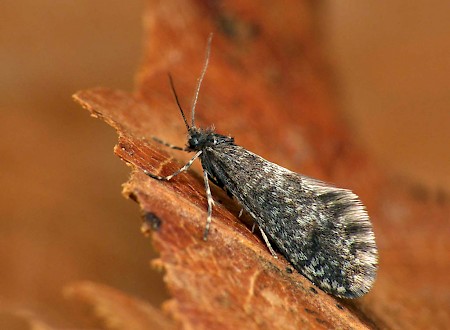
11.004 BF177
Lesser Lichen Case-bearer Dahlica inconspicuella
(Stainton, 1849)
Description by Ian F. Smith:
Wingspan (male) 9-13 mm. Description by Ian F. Smith:
Dahlica inconspicuella has been recorded locally, sometimes commonly, in southern England to Lancashire and Yorkshire, and nowhere else in the world. Like the other two British species of Dahlica, the female is wingless, but D. inconspicuella differs in having winged males.
The larva and its case are similar to the other Dahlica species and can be found on sunny rocks, stone walls, tree trunks, fences, or even old roofing felt on a strand line. Positions sheltered from the wind appear to be favoured. The case, triangular in cross section and tapered at both ends, is covered in granules of sand, with variable amounts of lichen and/or algae. It grows from June to March when it is about 6 mm long.
- More Details:
After overwintering as a larva, it attaches the anterior of the case by a pad of whitish silk to an upright surface exposed to the sun and pupates in the case. In March or April the pupa extrudes from the posterior (lower end) of the case for the moth to emerge. The wingless female then attracts a male and lays her eggs in the vacated case. Positive identification of females depends on dissection of the genitalia, or examination of the headplate of the female pupal exuviae. On D. inconspicuella, the antenna sheath and leg sheath are nearly the same length on the female pupa. Males are easily identified by their wings, or by the wing cases and much longer antennal sheaths on the exuviae, as the other two British Dahlica species do not have males. Bankesia conspurcatella also has a case with triangular cross section. It differs in overwintering as a pupa, and the male having a tiny spur on the tibia of the foreleg, and having cilia arranged all round the circumference of at least part of the antenna In Europe there are sixteen or more Dahlica species, including two-sex forms of the other two British species, which have males with similarly patterned wings. In the Netherlands, specimens of Dahlica sauteri (Hättenschwiler, 1977) have at times been recorded as D. inconspicuella. The female headplate of D. sauteri is very similar, having the leg sheath a similar length to that of the antenna sheath.
Larva: (based on MBGBI 2)
Food: Lichen. June to March.
Larval case: 5 to 6.5mm. Triangular cross section. Tapered both ends. Coated in lichen, fine sand and wood fragments.
Head: Blackish.
Prothorax (T1): Prothoracic shield blackish.
Mesothorax (T2): Pair of blackish spots.
Metathorax (T3): Pair of blackish spots. Body: Yellowish grey.Similar species: There has been much confusion with the identification of Dahlica spp. Useful references are MBGBI 2 and Schmetterlinge und ihre Lebensräume, Band 2. Published by Schweizerischer Bund für Naturschutz. (The Psychid contributions in both are by P. Hättenschwiler.) The female pupal headplate, often found displaced but still attached to the pupal exuviae, is a useful diagnostic feature. However, care should be taken, as the individual elements are rarely disposed in exactly the same positions after emergence. The angle of view can also cause variation.
- 176 Dahlica triquetrella Only wingless females in Britain. (Males occur at some mainland Europe sites). Larval case typically, but not always, has fragments of insect attached. (Beware insect fragments on 180 Diplodoma herminata and anterior 20% of 181 Taleporia tubulosa cases.) Pupal headplate has base of antenna swollen. Antenna sheath longer than leg sheath.
- 177 Dahlica inconspicuella Species not known outside Britain. Wingless females and winged males. Larval case sandy with variable amounts of lichen or algae. Female pupal headplate has leg and antenna sheaths nearly the same length.
- 179 Dahlica lichenella Only wingless females in Britain. (Males occur at some mainland Europe sites). Larval case sandy coated with variable amounts of lichen or algae. Antenna sheath much longer than leg sheath. Pupal headplate has base of antenna not swollen.

 UKMoths
UKMoths 





